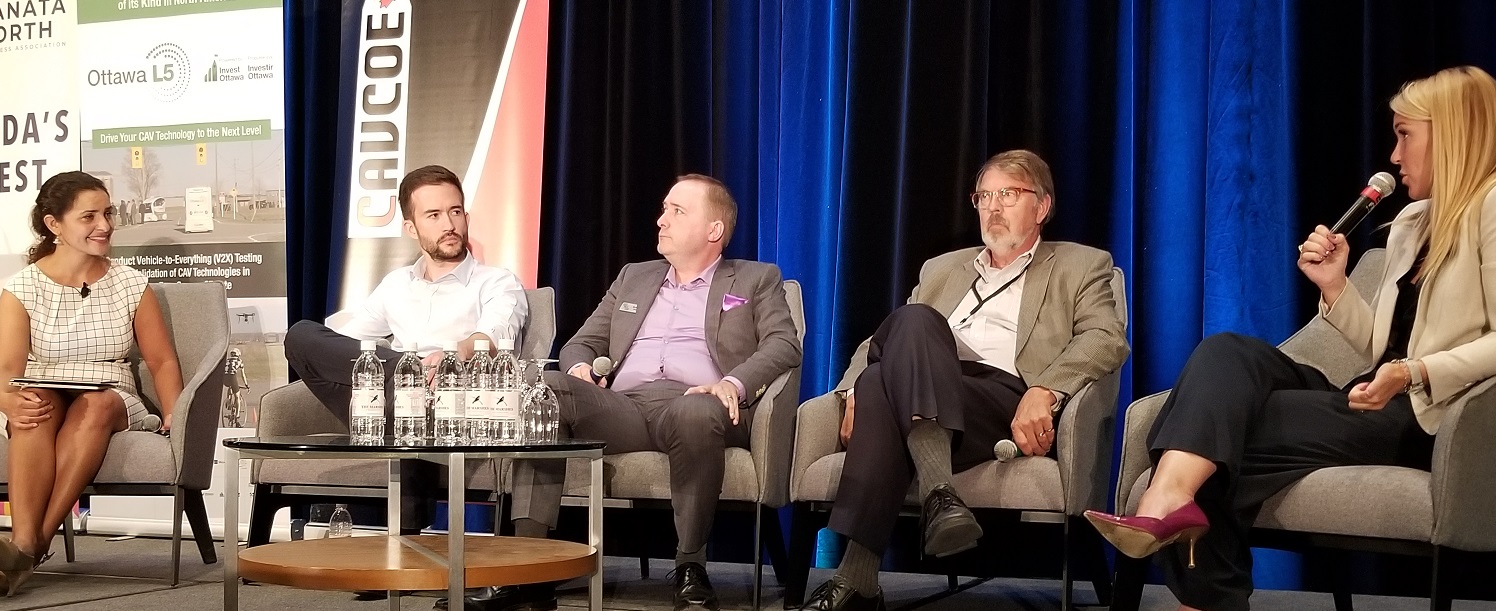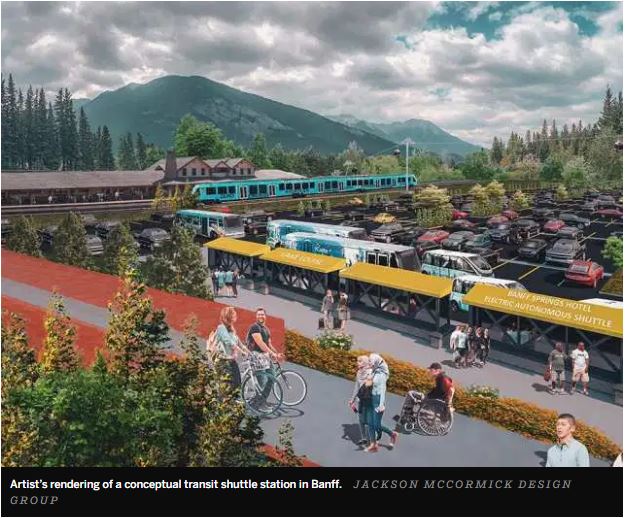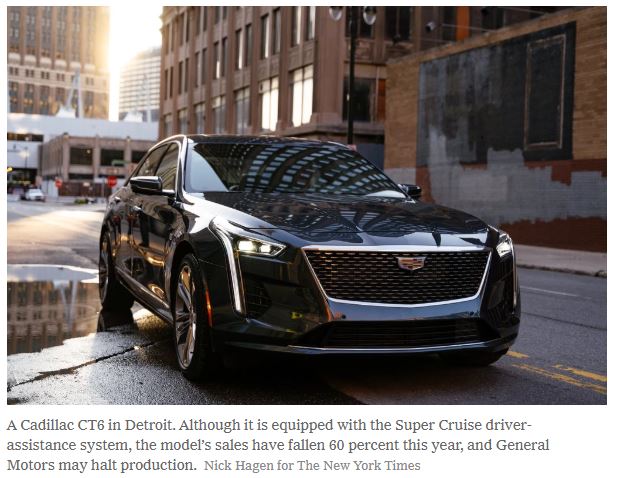From The Editors
Bob Plamondon had an interesting idea that he described in an op-ed in the Ottawa Citizen on Oct 2, 2019: a streetcar loop that runs through downtown Ottawa and Gatineau. The 4.5 km loop would help bring Gatineau and Ottawa together. I half agree with Bob. I like the idea of a transit loop, but streetcars are so 20th Century. I think that an autonomous electric shuttle would be better:
Canadian AV News
Unmanned Canada 2019 is a conference organized by
Unmanned Systems Canada (USC). The conference theme is
"Innovating Canada by Air, Land and Sea" and USC says that the
conference is Canada’s largest event in the unmanned and
remotely piloted vehicle sector. The program includes updates from Transport Canada, industry experts, academics and suppliers across all three sectors of the rapidly expanding world of unmanned technologies. Barrie Kirk is on the USC Board and has organized and is moderating a panel on "New Mobility" The conference will be held in Ottawa on October 30 - November 1, 2019. More information is available at the conference web-site. CAV Canada 2019 -- a conference on connected and automated vehicles was held in Ottawa in early September. It was organized by the Kanata North Business Association, Invest Ottawa, the Ottawa L5 test facilities and CAVCOE. The two-day conference featured presentations by Ford, GM and Airspace Experience Technologies. There were two streams in which panels discussed CAV technology and testing, as well as deployment issues such as business planning for the CAV era, government planning and regulations, demonstrations and pilots and the socio-economic impacts of AVs. Attendees left with a sense of how much has been achieved in the CAV space in Canada, but were also challenged to keep doing more to keep up with the competition in what looks destined to be a multi-trillion dollar sector of the economy in a few short years.  The National Association of City Transportation Officials (NACTO) held its latest conference in Toronto on September 9-12, 2019. One of the major announcements made at this conference was the publication of the second edition of the Blue Print for Autonomous Urbanism. This 132-page document focuses on the near-term policies and decisions that are necessary for autonomous technologies to flourish. Developed with a steering committee from NACTO’s 81 member cities and transit agencies, the second edition details the concrete steps that will need to be taken to ensure AVs go mainstream. More information at this link. A copy of the new report can be downloaded from this link. In another development announced by Mayor John Tory at the NACTO conference, the City of Toronto has selected the Rouge Hill community in Scarborough for its driverless shuttle trial. The shuttle will provide service to Rouge Hill’s GO Transit station. The goal of the pilot is to determine whether autonomous vehicles could help connect residents in low-density areas where demand doesn’t support conventional bus service to public transit. The cost of the project is estimated at $1.2 million. It will be jointly funded by Transport Canada, the City of Toronto, Toronto Transit Commission (TTC) and Metrolinx. Additional information is available at the City of Toronto's web site for its automated shuttle trial. Some highlights are:
Also in September 2019, the Ontario Centres of Excellence (OCE) in collaboration with Ontario-based Autonomous Vehicle Innovation Network (AVIN), Automotive Parts Manufacturers’ Association (APMA) and Deloitte Canada published a 37-page report titled Cybersecurity for Connected & Autonomous Vehicles: Considerations & Opportunities for Growth. The report provides a high-level overview of the CAV cybersecurity threat landscape and highlights both the opportunities and risks associated with emerging CAV technologies with a focus on strategies, standards, solutions and market opportunities for Ontario. A copy of the report can be downloaded from OCE's website at this link. Global Affairs Canada in partnership with Invest Ottawa and the Israel Innovation Authority has organized a trade mission to Israel for the EcoMotion Conference on October 28-29, 2019. This trade mission is a good opportunity for Canadian organizations active in CAV to seek alliances and partnerships with Israeli companies and others active in this field. More information is at this link and at EcoMotion’s own site at this link. The mountain town of Banff, Alberta is a very popular tourist magnet. However, the high number of visitors has caused serious congestion problem in Banff. Proposals have been made by the Town of Banff and other parties to address the traffic issue. One of the latest proposals is by the owners of Mount Norquay Ski Resort. Dubbed eco-transit hub, it envisions a dedicated rail line from Calgary to Banff, an aerial transit system (gondola) to take visitors from the train station to the ski resort, and automated vehicles for shuttling passengers between various points in Banff. Cost of these proposals is estimated at over $600 million. More information about the proposal is at this link. 
We don't normally include a job-wanted ad, but this
looked interesting. Kinetic Intelligence Systems
is a newly formed Canadian technology company
undertaking research and prototype development in the
field of airborne wind energy systems. Kinetic has an
immediate opening for a graduate. The required
expertise includes developing and using open source
drone software to test the prototype. If you are
interested, please write to us for the contact at
Kinetic.
International AV News UK organization Zenzic (formerly Meridian Mobility) is a government-industry partnership to promote autonomous vehicle technology in the UK. In early September 2019, Zenzic published a 108-page report titled UK Connected and Autonomous Mobility Roadmap. The report identifies 500+ milestones required to get self-driving vehicles on Britain’s roads at scale by 2030. More information is at this link. A copy of the 108-page report can be viewed/downloaded from this link. Companies active in developing self-driving area are very secretive about proprietary technologies. It therefore came as a surprise that Waymo -- a dominant company in the field -- decided to release some of its self-driving data to the public to help with more R&D in this area. Waymo is making some of the high-resolution sensor data gathered by its fleet of AVs available to researchers. The Waymo data-set contains 1,000 driving segments, with each segment capturing 20 seconds of continuous driving. These will allow researchers to develop their own models to track and predict the behavior of everyone using the road, from drivers to pedestrians to cyclists More information is at this link. Staying with Waymo, its CEO John Krafcik has revealed that his company abandoned developing a semi-autonomous system called AutoPilot about six years ago (not to be confused with Tesla’s Autopilot system). The reason for this was the fact that Google employees testing the vehicles became too trusting of the system. In fact, one fell asleep at the wheel while traveling at 55 mph on a highway. Waymo changed direction in favour of a self-drive system requiring no human supervision. Both Tesla's and Cadillac's current self-drive systems resemble the semi-autonomous system originally developed by Waymo. More information at is this link. AVs are often portrayed as an enabler for seniors and people with disabilities. The Independent Transportation Network of America (ITNAmerica) is a non-profit transportation network for seniors and people with visual impairments in the United State. While it supports development of AVs, it also recognizes that older people or those with disabilities still need human assistance for getting around, e.g. to help carry packages, fold walkers, open doors and lend an arm for balance and security. ITN believes developers of AVs can learn a lot from the non-profit volunteer organizations like it. More information is at this link. The New York Times of August 27, 2019 published an article on the waning fortunes of GM’s Cadillac brand. Once an epitome of luxury and advanced technologies, it has fallen far behind its European and Japanese luxury car rivals. Now Cadillac is hoping its Super Cruise self-drive system will restore some of its former shine to its brand. The NYT article can be viewed at this link.  Cruise is the AV arm of General Motors and is valued at several billion dollars. Cruise is based in San Francisco and does a lot of its real-world testing on the public roads in that city. Cruise attempts to connect with the people of San Francisco through social interactions and participating in local events. To this end, it publishes its own monthly Community Newsletter to keep San Franciscans apprised of its community activities. Check this link for a recent edition of Cruise’s Community Newsletter. As in other industries, the trucking industry is also looking for increased efficiencies and lowering of operating costs through automation. To this end, truck platooning (also called auto-follow) and driverless trucks have been under development by several companies. In a detailed article in the August 30, 2019 edition of Forbes magazine, the merits of each technology is analyzed and predictions made as to which technology is more likely to see commercialization by the trucking industry. At present, 27 states in the U.S. allow truck platooning on their public roads. Platooning is estimated to reduce fuel and labour costs by up to 10% for fleet operators. The Forbes article can be viewed at this link. The U.S. Department of Transportation (USDoT) has awarded nearly US$60m in federal grants for the development and integration of Automated Driving Systems (ADS) on U.S. roads. Eight projects will be funded under this program. The main aim of these projects is to gather sufficient safety data to facilitate rule-making by USDoT and to promote collaboration between state, local government and private partners. The recipients are: Texas A&M, University of Iowa, Virginia Tech, Ohio Department of Transportation, Pennsylvania Department of Transportation, City of Detroit and Contra Costa Transportation Authority. More information is at this link and at USDoT’s own site at this link. The European Organization for Nuclear Research (CERN) is renowned for projects such as the Large Hadron Collider (LHC). The LHC produces vast quantities of data. CERN has developed advanced AI and Machine Learning techniques for dealing with this deluge of data. In a collaboration between CERN and the Swedish AV software developer Zenuity, these techniques will be applied to the large quantity of data produced by AVs such as identifying pedestrians, vehicles and the streams of data produced by the sensors on the car, including cameras, LiDAR, radars and other sensors. More information is at this link. Waymo launched its robotaxi service in Arizona in December 2018. This has generated a lot of feedback from passengers using this service. Now 10,500 of these customer feed-backs has been analyzed by an organization called Information. While 70% of riders gave their ride quality a 5-star rating, the rest were not as impressed. Complaints range from questionable drop-offs, circuitous routes and shaky driving. More information is at this link. Oct 15-16, 2019: ITS (UK) Summit, Coventry, England Oct 15-16, 2019: World Congress and Challenge for Self-Driving Transport, Dubai, UAE Oct 21-25, 2019: ITS World Congress, Singapore
Oct 22-24, 2019:
Autonomous Vehicle Test and Development Symposium; Novi MI, USA
Oct 28-29, 2019:
EcoMotion Conference, Tel Aviv, Israel Oct 30-Nov 1, 2019: Unmanned Canada 2019, organized by Unmanned Systems Canada; Ottawa, Canada Nov 26-27, 2019 The Future of Transportation World Conference, Vienna, Austria Jan 7-10, 2020 CES 2020, Las Vegas NV
Oct 4-8, 2020:
ITS World Congress, Los Angeles |
|||||
|
AV Update
is a free, monthly roundup of news and analysis in the world of
automated vehicles and their impact on all levels of government
and the private sector.
Chief Editor: Ahmad Radmanesh Contributors to this issue: Barrie Kirk, Paul Godsmark To subscribe, click here. To unsubscribe, click here. We welcome all comments; please send them here © CAVCOE 2019 CAVCOE (formerly the Canadian Automated Vehicles Centre of Excellence) provides advice to public and private sector organizations to help plan for the arrival of self-driving vehicles |